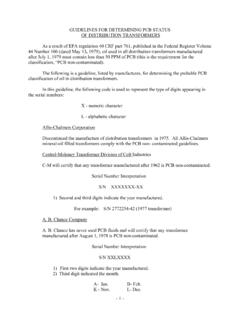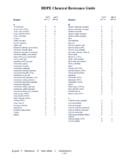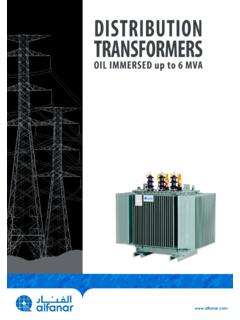Transcription of On-LOAd AP-ChAngErsT FOr POwEr TrAnsFOrmErs
1 AUThOr: dr. dIeTer dOhnaL On-LOAd TAP-ChAngErsFOr POwEr TrAnsFOrmErsMR KNOWLEDGE BASEOn-LOad Tap-Changers fOr POwEr TransfOrmersAbstractOn-load tap-changers (OLTCs) are indispensable in regulating POwEr TrAnsFOrmErs used in electrical en-ergy networks and industrial paper explains the technological developments of resistor-type OLTCs and reactor-type OLTCs. The general switching principles for OLTCs are discussed and OLTC applications are s OLTC design concepts, including the new generation of vacuum type OLTCs, are described. The vacuum switching technology used in OLTCs is the state of the art design now and in the foreseeable future. Examples of OLTC designs and the respective switching principles show the range of the usage of vacuum interrupters1.
2 IntroductionPower TrAnsFOrmErs equipped with On-LOAd tap-changers (OLTCs) have been the main components of electrical networks and industrial applications for nearly 90 years. OLTCs enable voltage regulationand/or phase shifting by varying the transformerratio under load without interruption. From the start of tap-changer development, two switching principles have been used for load transfer operation the high-speed resistor-type OLTCs and the reactor-type the decades both principles have been devel-oped into reliable transformer components which are available in a broad range of current and voltage applications. These components cover the needs of today s network and industrial process TrAnsFOrmErs and ensure optimal system and process control [1].
3 The majority of resistor-type OLTCs are installed in-side the transformer tank (in-tank OLTCs) whereas the reactor-type OLTCs are in a separate compart-ment which is normally welded to the transformer tank (fig. 1).This paper mainly refers to OLTCs immersed in trans -former mineral oil. The use of other insulating fluids or gas insulation requires the approval of the OLTC manufacturer and may lead to a different OLTC de-sign, as shown in chapter TAP-ChAngErs FOr POwEr TrAnsFOrmErs2 . mr KnOwLedge BaseContent Page1. Introduction 22. switching principle 33. On-LOAd tap-changer applications 44. design concepts of today s On-LOAd tap-changers 75. Example of maintenance strategy and operating costs example resistor vacuum-type OLTCs VACUTAP Vr , V V and Vm 206.
4 Selection of On-LOAd tap-changers 217. Conclusions 238. Literature 24 Fig. 1: OLTC arrangementsCompartment type In-tank type32. switching principleThe OLTC changes the ratio of a transformer by add-ing or subtracting to and turns from either the pri-mary or the secondary winding. The transformer is therefore equipped with a regulating or tap winding which is connected to the 2 shows the principle winding arrangement of a 3-phase regulating transformer, with the OLTC lo-cated at the wye-delta-connection in the high volt-age changing of taps during an energized status is unacceptable due to momentary loss of system load during the switching oper ation (fig. 3). The make (2) before break (1) contact concept , shown in Figure 4, is therefore the basic design for all OLTCs.
5 The transi-tion impedance in the form of a resistor or reactor consists of one or more units that bridge adjacent taps for the purpose of transferring load from one tap to the other without interruption or appreciable change in the load current. At the same time they limit the circulating current (I C ) for the period when both taps are used. normally, reactor-type OLTCs use the bridging position as a service position and the re-actor is therefore designed for continuous voltage between the taps mentioned above is the step voltage, which normally lies between % and % of the rated voltage of the main components of an OLTC are contact systems for make and break currents as well as carrying cur-rents, transition impedances, gearings, spring energy accumulators and a drive mechanism.
6 Depending on the various winding arrangements (details in chap-ter 3) and OLTC-designs, separate selector switches and change-over selectors (reversing or coarse type) are also : step voltageI: Through-currentarcingI: Through-currentUsHigh voltage windingLow voltage windingReactor principle(preventive auto transformer)Resistor principleFig. 2: Principle winding arrangement of a regulating transformer in wye-delta-connectionFig. 3: Loss of system load with single contact switchingFig. 4 : Basic switching principle make (2) before break (1) using transition impedances3. On-LOAd tap-changer Basic arrangements of regulating windingsThe following basic arrangements of tap windings are used (fig. 5):Linear arrangement (fig. 5 a), is generally used on POwEr TrAnsFOrmErs with moderate regulating ranges up to a maximum of 20 %.
7 The tapped turns are add-ed in series with the main winding and changes the transformer ratio. The rated position can be any one of the tap a reversing change-over selector (fig. 5 b) the tap winding is added to or subtracted from the main winding so that the regulating range can be doubled or the number of taps reduced. during this opera-tion, the tap winding is disconnected from the main winding (for problems arising from this disconnection see chapter ). The greatest copper losses occur, however, in the position with the min i mum number of effective turns. This reversing operation is realized using a change-over selector which is part of the tap selector or of the selector switch (arcing tap switch). The rated position is normally the mid position or neutral position.
8 The double reversing change-over selector (fig. 5 c) avoids the disconnection of tap winding during the change-over operation. In phase-shifting transform-ers (PsT) this apparatus is called the advance-retard switch (Ars).Using a coarse change-over selector (fig. 5 d) the tap winding is connected either to the plus or minus tapping of the coarse winding. during coarse selec-tor operation, the tap winding is disconnected from the main winding (special winding arrangements can cause the same disconnection problems as described above; in addition the series impedance of coarse winding/tap winding must be checked see chap-ter ). In this case, the copper losses are lowest in the position of the lowest effective number of turns. This advantage, however, places higher demands on insulation material and requires a larger number of windings.
9 The multiple coarse change-over selector (fig. 5 e) enables multiplication of the regulating range. It is mainly used for industrial process TrAnsFOrmErs (rec-tifier/furnace TrAnsFOrmErs ). The coarse change-over selector is also part of the of these basic winding arrangements is used in each individual case depends on the system and operating requirements. These arrangements are ap-plicable to two winding TrAnsFOrmErs as well as to autotransformers and to phase-shifting transform-ers (PsT). where the tap winding and therefore the OLTC is inserted in the windings (high-voltage or low-voltage side) depends on the transformer design and customer . mr KnOwLedge BaseOn-LOad Tap-Changers fOr POwEr TransfOrmersa) linearb) single reversing change-over selectorc) double reversing change-over selectord) single coarse change-over selectore) multiple coarse change-over selectorFig.
10 5: Basic connections of tap examples of commonly used winding schemesTwo winding TrAnsFOrmErs with wye-connected windings have regulation applied to the neutral end, as shown in figure 6. This results in relatively simple and compact solutions for OLTCs and tap 6: OLTC with neutral end of tap windingFig. 7: OLTC with delta-connection of tap windingregulation of delta-connected windings (fig. 7) re-quires a three-phase OLTC whose three phases are insulated according to the highest system voltage applied (fig. 7 a), or 3 single-phase OLTCs, or 1 single-phase and 1 two-phase OLTC (fig. 7 b). Today, the design limit for three-phase OLTCs with phase-to-phase insulation is the highest voltage for equipment of 145 kV (BIL 650 kV). To reduce the phase-to-phase stresses on the delta-OLTC the three pole mid-wind-ing arrangement (fig.)




